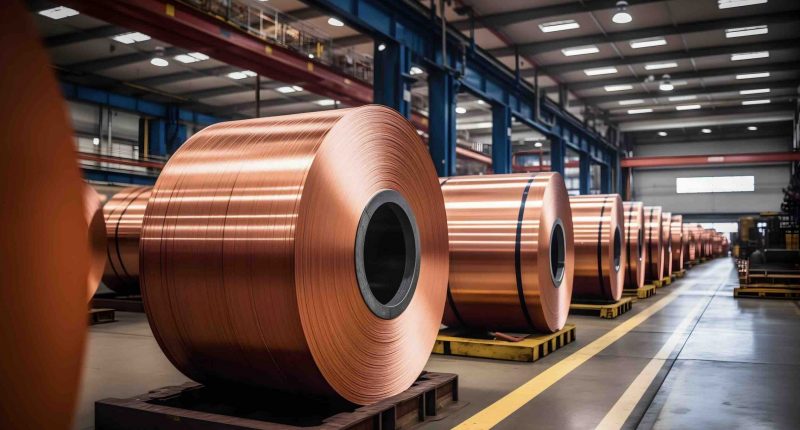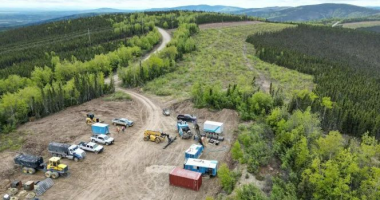Here’s the one-sentence explanation for why copper prices are rising: as decarbonisation projects become more and more common, which typically require renewable energy assets, demand for copper is increasing too fast for supply to keep up.
If that’s not making immediate sense, think big and small Li-Ion batteries (which contain a lot of copper) as well as the copper used in wind turbines, solar panels, and so on. (Imagine how much copper a hydrogen electrolyser must need.)
If you follow the materials sector closely, you’re likely aware that copper prices have had a strong YTD run, and over the last month, they’re up nearly +15%.
Year on year, those prices are up just over +17%.
These metrics do give some idea of the relative strong performance driving copper commodity prices.
But traders tend to look at something else when it comes to copper – what it costs per tonne.
And right now, as of 29 April 2024 Australian arvo time, copper prices have clocked over US$10,000/tn in London – a key psychological benchmark for copper bulls everywhere.
Only late last month, BMO Capital Markets called a US$9,000/tn milestone. We’ve since soared far past that.
World markets are going off in a good way, apparently for the sake of it – we’ve seen that in uranium, gold, and the NASDAQ YTD – and copper’s along for the ride, too.
US$10,000/tn copper is here – if only just. Futures traders, for what they’re worth, expect prices to remain high until at least July per Investing.

What’s going on with supply?
What we’re seeing is widely accepted to be a supply side story, a theory backed by Bank of America’s Asia-Pacific metals chief Matty Zhao.
Jevons Global’s Kinglsey Jones also wrote a fantastic breakdown on this issue for The Market Online in the recent past.
Put simply, multiple copper mines the world over are having problems with output at the moment right now – that’s the easiest way to say it.
In the meantime, renewables-led demand continues to grow too fast for copper miners to catch up broadly.
If you’ll let me go on a tangent for a moment – this growing copper supply shortfall is part of the reason why BHP (ASX:BHP) remains closely watched by analysts, despite its profits hitting a 10Y low in early 2024.
BHP’s purcahse of Oz Minerals in 2023 saw it become a more significant copper player, so there’s evidence of a mining giant shoring up copper plays.
Good timing, too, for a company that has recently flagged a multibillion dollar writedown of its Nickel West project while the price for that commodity tanks.
It’s also now seeking to buy Anglo American in a deal that many believe is also related to BHP’s efforts to shore up its scale as a copper miner. Rio Tinto (ASX:RIO) is quite attached to its Mongolian Oyu Tolgoi project, too.
But, back to copper prices.
Copper price rise was predicted last year
At the same time output around the world started to falter, Chinese smelters also stopped producing so much copper, due to lower margins. Cue another reason for a bull run on the price of copper.
But some have been calling a broader copper price run for quite some time, with forecasts of a looming deficit old news by now (notwithstanding there’s always someone forecasting a deficit for something.)
In a June 2023 note, Citigroup analysts wrote that “the scale of [decarbonisation demand inflows] are likely to overwhelm copper’s tiny physical market.”
Meanwhile, in June of last year, UBS was forecasting a growing copper deficit to hit the markets in 2025. (Nickel bulls are probably still healing from their wounds.)
But that was in June of last year. What are analysts expecting in Q2 of 2024 and beyond?
Copper forecasts 2024: what the experts think
So, BMO Capital Markets called it rightly back in March, and then became victims of their own success.
As of late April 2024, what are others saying?
- SAXO Markets: Based on a technical analysis, SAXO analysts believe we could see a -5% correction in copper prices in the near future.
- Benchmark Minerals Intelligence: Has not named a figure but the Fitch subsidiary expects a decline in the USD through H2CY24 to help push copper prices higher.
- ANZ Bank: Had previously said copper would hit US$10,000/tn back in March, along with BMO – but had called US$9,000/tn in the short term.
- ING Bank: In late March, also called copper reaching US$9,000/tn by EOCY2024 – suggesting ING’S analysts might side with SAXO’s correction call.
- Morgan Stanley: Earlier this month, the investment bank said it expects copper prices to rise by 15% on the London Metals Exchange (LME) by EOCY2024.
- Goldman Sachs: Joining the bull camp, the investment bank’s analysts in late March said they see a US$10,000/tn price for the end of the year – a call they’re most likely quite happy about (currently.)
A lot of people will probably be keeping an eye on copper junior explorers – more than they always have been, anyway.
For my part, I find it curious no-one is asking about the slowed-down Chinese economy when it comes to copper.
But conforming with the trends of this year, right now, nobody cares about bad news.








